

In the Team Montréal house, a green roof and a green wall reduce energy used for cooling and add insulation as well as rain water recovery.
Download Construction Drawings
(Zip 18 MB)
Neither the United States, nor the Department of Energy, nor the Alliance for Sustainable Energy LLC, nor any of their contractors, subcontractors, or their employees make any warranty, express or implied, or assume any legal liability or responsibility for the accuracy, completeness, or usefulness for any purpose of any technical resources or data attached or otherwise presented here as reference material.
Solar Decathlon 2007
Team Montréal
(École de Technologie Supérieure, Université de Montréal, and McGill University)
Polar Revolution
Team Montréal is starting a Polar revolution to make solar energy popular in cold northern climates. The biggest challenge for the students is convincing their northern audience that solar technology works well in very cold climates.
"The most important thing for us was to focus on the building envelope," says Joanna Rosvalt, an architecture student from McGill University. "It had to be both functional and aesthetic."
The building envelope starts with a special structural steel frame that is easy to assemble and disassemble. The walls are "clipped" directly to the steel frame and are insulated with polyurethane made from soybeans and recycled plastic to trap heat inside the home. Windows are triple glazed, low e, and have automated shading to further trap heat.
On the roof, 40 PV panels producing 8.2 kW will also be clipped to the structure, so they won't need any other roofing under the PV system, reducing the cost and use of unnecessary materials. Two solar thermal collectors heat enough water for the radiant floor and household use.
The team tried to integrate as many locally made and raw materials into the house as possible to reduce the environmental impact caused by shipping. For example, most of the furniture in the house will be made of reused materials.
A unique feature of the home is the use of artificial intelligence for temperature control and energy use. The "house" will search the Web for the weather forecast to predict the amount of energy it will be able to produce in the days to come and how much it will need for its occupants. The system will recommend energy use choices to meet upcoming demands. The system controls heating, cooling, lighting, shading, and ventilation, all with one interface.
"I always dreamed of living in a smart home that could be autonomous and ecological," says École de Technologie Supérieure student Michael Chapman. "Isn't it amazing to be able to build one?"
Team Contact
Prof. Hughes Rivard
hugues.rivard@etsmtl.ca
